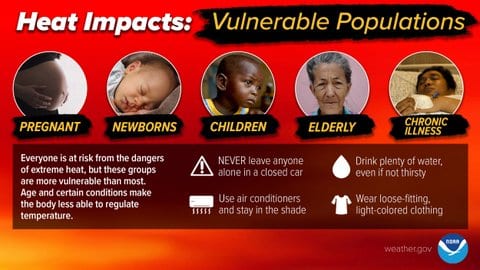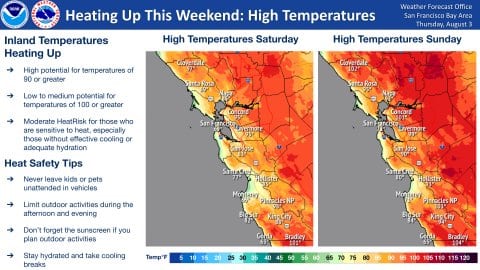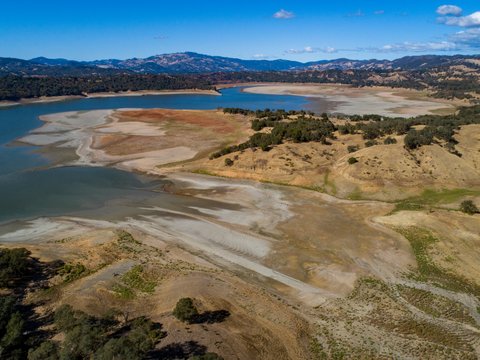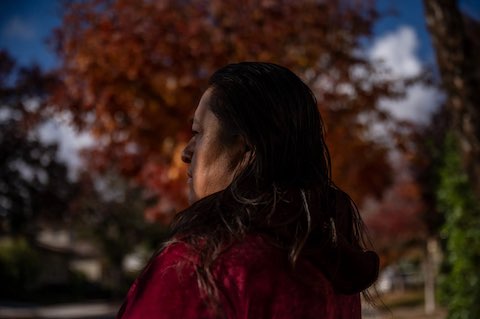
13 Jul California’s Top Agencies Brace for Severe Heat Across the State

(National Weather Service via Bay City News)
By Olivia Wynkoop
Bay City News
As California braces for an extreme heat event this week, state officials said Wednesday that they are working hard to keep residents informed on how to protect themselves.
The announcement came after the National Weather Service issued an excessive heat watch Monday for the interior areas of the Bay Area and along the central coast. The weather service predicts the heat event will peak this weekend in the Bay, with some areas expected to reach temperatures in the upper 90s and lower 110s.
The weather service said much of California and the western portion of the U.S. will endure “some of the worst heat waves this area has ever seen.”
The expected extreme heat conditions prompted California to move into Phase 2 of its Extreme Temperature Response Plan on Tuesday, which focuses on coordinating state and local agencies to issue resources during heat watches and warnings.
Brian Ferguson of the California Governor’s Office of Emergency Services said that hot weather at this time of year is not unexpected, and is something that will only increase as California faces more dry spells and extreme weather due to climate change. What does change, however, is how heat will interact with California’s other threats it faces, like wildfires and power grid reliability, he said.
With Climate Change, Comes More Potential Complications for People with Lupus
“Extreme heat is a killer. More than any disaster we face, we see more fatalities from heat,” Ferguson said. “Earthquakes and fires are more dramatic — flooding is also a killer — but not nearly to the extent that he impacts our state every single year.”
“We as administration are taking really proactive steps to try to engage and be on the front foot on this to protect our communities,” he added.
On Tuesday, Gov. Gavin Newsom launched a $20 million campaign to better prepare communities for extreme heat, called Heat Ready CA.
Led by the Governor’s Office of Community Partnerships and Strategic Communications, the outreach campaign will boost public awareness with advertising, social media and influencer engagement, and will specifically target those most vulnerable to heat-related illnesses, like older adults, outdoor workers and people with chronic medical conditions. It also plans to bolster relations with 100 media and community organizations across different demographics that can provide culturally-competent information about heat waves in 30 different languages.
But ultimately, residents are encouraged to stay cool, drink water and look after their neighbors in the event of a heat wave.
Director of the California Department of Public Health Dr. Tomas Aragon said that the warning signs of heat-related illness can vary based on severity, but include sweating, muscle aches, weakness, headaches, nausea, dizziness, confusion and a change in mental status.
“We know who’s at risk and obviously vulnerable, but [also] vulnerable is all of us,” Aragon said. “You can be young and healthy and quickly get into trouble, because if you’re out exerting exercise and physical activity, you’re producing heat.”
Chief of California Division of Occupational Safety and Health Jeff Killip said that outdoor workers or indoor workers exposed to high heat are especially at risk of heat-related illnesses. He said that all California employers are required to prevent their workers from falling into heat illness by providing water, allowing short breaks when their workers need to cool down, ensuring workers have access to shade and having emergency procedures in place in case a worker gets sick.
“Our team is out in full force right now conducting targeted inspections to ensure employers are complying with the law with a focus on construction, agriculture. tree trimming, landscaping, carwash and warehouse industries,” Killip said.
He added that any worker who believes their workplace is in violation of workplace safety and health laws are encouraged to contact the agency, which they can do confidentially.
Secretary Wade Crowfoot from California Natural Resources said that alongside boosting public awareness and sending out early warnings about heat events, the state also plans to better surveil these events and monitor their impacts. Recent funding will also allow the state to update its infrastructure to adjust to higher temperatures, which includes retrofitting buildings and expanding tree canopies in communities.
“We have a state are focused on providing more tools, nore public awareness, more infrastructure upgrades to ensure that our Californians can continue to thrive, even amidst this changing weather,” Crowfoot said.
Copyright © 2023 Bay City News, Inc. All rights reserved. Republication, rebroadcast or redistribution without the express written consent of Bay City News, Inc. is prohibited. Bay City News is a 24/7 news service covering the greater Bay Area.






No Comments